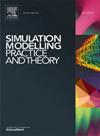Modelling and visualization behavior simulation in public open spaces based on MLP and SFM
IF 3.5
2区 计算机科学
Q2 COMPUTER SCIENCE, INTERDISCIPLINARY APPLICATIONS
引用次数: 0
Abstract
This research is grounded in the analysis of real human activity data in public open spaces (POS) and investigates the utilization patterns of 45 spatial segments and 121 subspaces within Shanghai's waterfront public areas. Employing a multi-layer perceptron neural network model, we explore the mechanisms by which 30 space, environmental, and facility factors influence various activities, including sightseeing, leisure, and sports. These findings are then integrated into a behavior simulation visualization system. Following a fitting and adjustment process, we validate the effectiveness of this behavior simulation system. The research outcomes reveal the robust performance of the multi-layer perceptron in predicting pedestrian activity in public spaces. Translating numerical predictive models into dynamic systems of behavioral simulation driven by social force model (SFM), we observe a relative error (RE) range of 0.041–0.158, with minimal loss of fit. Finally, through practical case testing, we illustrate the application of this behavior simulation workflow. The primary objective of this research is to provide predictive and scientific foundations based on human behavioral requirements for the design and optimization of POS, supporting human-centric and refined design decisions for urban landscape space.
基于MLP和SFM的公共开放空间建模与可视化行为仿真
本研究基于公共开放空间(POS)的真实人类活动数据分析,探讨了上海滨水区公共区域45个空间段和121个子空间的利用模式。采用多层感知器神经网络模型,我们探索了30个空间、环境和设施因素影响各种活动的机制,包括观光、休闲和运动。然后将这些发现整合到行为模拟可视化系统中。经过拟合和调整过程,我们验证了该行为模拟系统的有效性。研究结果表明,多层感知器在预测公共空间行人活动方面具有良好的鲁棒性。将数值预测模型转化为社会力模型驱动的动态行为模拟系统,我们观察到相对误差(RE)范围为0.041-0.158,拟合损失最小。最后,通过实际案例测试,说明了该行为模拟工作流的应用。本研究的主要目的是为POS的设计与优化提供基于人类行为需求的预测和科学依据,支持以人为本的城市景观空间精细化设计决策。
本文章由计算机程序翻译,如有差异,请以英文原文为准。
求助全文
约1分钟内获得全文
求助全文
来源期刊

Simulation Modelling Practice and Theory
工程技术-计算机:跨学科应用
CiteScore
9.80
自引率
4.80%
发文量
142
审稿时长
21 days
期刊介绍:
The journal Simulation Modelling Practice and Theory provides a forum for original, high-quality papers dealing with any aspect of systems simulation and modelling.
The journal aims at being a reference and a powerful tool to all those professionally active and/or interested in the methods and applications of simulation. Submitted papers will be peer reviewed and must significantly contribute to modelling and simulation in general or use modelling and simulation in application areas.
Paper submission is solicited on:
• theoretical aspects of modelling and simulation including formal modelling, model-checking, random number generators, sensitivity analysis, variance reduction techniques, experimental design, meta-modelling, methods and algorithms for validation and verification, selection and comparison procedures etc.;
• methodology and application of modelling and simulation in any area, including computer systems, networks, real-time and embedded systems, mobile and intelligent agents, manufacturing and transportation systems, management, engineering, biomedical engineering, economics, ecology and environment, education, transaction handling, etc.;
• simulation languages and environments including those, specific to distributed computing, grid computing, high performance computers or computer networks, etc.;
• distributed and real-time simulation, simulation interoperability;
• tools for high performance computing simulation, including dedicated architectures and parallel computing.
 求助内容:
求助内容: 应助结果提醒方式:
应助结果提醒方式:


